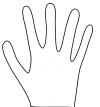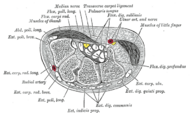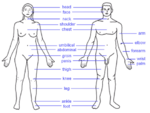Thumb
| The Thumb | |
|---|---|
|
|
|
| The 'thumbs up' gesture is a sign of approval in many cultures, and an obscene gesture in many others. | |
| Latin | pollex, digitus primus, digitus I |
| Artery | princeps pollicis artery |
| Lymph | infraclavicular lymph nodes[1] |
| MeSH | Thumb |
| Fingers |
 |
The thumb is the lateral-most digit of the hand. The English adjective for thumb is pollical.
Contents |
Anatomy of the opposable thumb
Bones
The thumb consists of three bones:
- distal phalanx (of the first digit)
- proximal phalanx (of the first digit)
- first metacarpal
Muscles

Its movements are controlled by eight muscles (each with "pollicis" in the name):
| Name | Location | Nerve |
| extensor pollicis longus | forearm | posterior interosseous nerve |
| abductor pollicis longus | forearm | posterior interosseous nerve |
| flexor pollicis longus | forearm | anterior interosseous nerve |
| extensor pollicis brevis | forearm | posterior interosseous nerve |
| abductor pollicis brevis | hand | median nerve |
| flexor pollicis brevis | hand | median nerve |
| opponens pollicis | hand | median nerve |
| adductor pollicis | hand | ulnar nerve (deep branch) |
The extensor pollicis longus tendon and extensor pollicis brevis tendon form what is known as the anatomical snuff box (an indentation on the lateral aspect of the thumb at its base) The radial artery can be palpated anteriorly at the wrist(not in the snuffbox) In the hand, the abductor pollicis brevis, adductor pollicis, flexor pollicis brevis, and opponens pollicis form the thenar eminence.

Hitchhiker's thumb
The thumb when extended (as in a "thumbs-up") can also appear to bend backwards toward the nail and outwards, a recessive congenital condition known as "hitchhiker's thumb", whereas for other people it will extend straight out with little backward bending. Having either condition appears to have no effect on the thumb's function.
As one of five digits, and as companion to four fingers
The English word "finger" has two senses, even in the context of appendages of a single typical human hand:
- The four digits, not including the thumb.
- Any of the five digits.
Linguistically, it appears that the original sense was the broader of these two: penkwe-ros (also rendered as penqrós) was, in the inferred Proto-Indo-European language, a suffixed form of penkwe (or penqe), which has given rise to many Indo-European-family words (tens of them defined in English dictionaries) that involve or flow from concepts of fiveness.
The thumb shares the following with each of the (other) four fingers:
- Having a skeleton of phalanges, joined by hinge-like joints that provide flexion toward the palm of the hand
- Having a "back" surface that features hair and a nail, and a hairless palm-of-the-hand side with fingerprint ridges instead
The thumb contrasts with each of the (other) four by being the only finger that:
- Is opposable
- Has two phalanges rather than three
- Has its inmost phalanx so close to the wrist
- Has much greater breadth and stubby proportions
- Is attached to such a mobile metacarpus (which produces most of the opposability)
Grips
Typical interdigital grips include the tips of thumb and second finger (forefinger/index finger) holding a pill or other small item, or thumb and sides of second and third fingers holding a pen or pencil.
Origin of the Human thumb
The evolution of the opposable or prehensile thumb is usually associated with Homo habilis, the forerunner of Homo sapiens.[2][3][4] This, however, is the suggested result of evolution from Homo erectus (around 1 mya) via a series of intermediate anthropoid stages, and is therefore a much more complicated link.
The most important factors leading to the habile hand (and its thumb) are:
- the freeing of the hands from their walking requirements—still so crucial for apes today, as they have hands for feet, which in its turn was one of the consequences of the gradual pithecanthropoid and anthropoid adoption of the erect bipedal walking gait, and
- the simultaneous development of a larger anthropoid brain in the later stages.
It is possible though that a more likely scenario may be that the specialized, precision gripping hand (equipped with opposable thumb) of Homo habilis preceded walking, with the specialized adaptation of the spine, pelvis and lower extremities proceeding a more advanced hand. And, it is logical that a conservative, highly functional adaptation be followed by a series of more complex ones that complement it. With Homo habilis an advanced grasping-capable hand was accompanied by facultative bipedalism, possibly implying, assuming a co-opted evolutionary relationship exists, that the latter resulted from the former as obligate bipedalism was yet to follow.[5] Walking may have been a byproduct of busy hands and not vice versa.
Importance of the opposable thumb
The thumb, unlike other fingers, is opposable, in that it is the only digit on the human hand which is able to oppose or turn back against the other four fingers, and thus enables the hand to refine its grip to hold objects which it would be unable to do otherwise. The opposable thumb has helped the human species develop more accurate fine motor skills. It is also thought to have directly led to the development of tools, not just in humans or their evolutionary ancestors, but other primates as well. The opposable thumb ensured that important human functions such as writing were possible.[6][7] The thumb, in conjunction with the other fingers make humans and other species with similar hands some of the most dexterous in the world.[8]
Other animals with opposable thumbs
Many animals, primates and others, also have some kind of opposable thumb or toe.

- Orangutan - opposable thumbs on both hands and both feet. The interdigital grip gives them the ability to pick fruit.
- Gorillas - opposable on both hands and both feet.
- Chimpanzees have opposable thumbs on both hands and both feet.
- Lesser Apes have opposable thumbs on both hands and both feet.
- Old World Monkeys, with some exceptions, such as the genera, Piliocolobus and Colobus.
- Cebids (New World primates of Central and South America) - some have opposable thumbs.
- Koala - opposable toe on each foot, plus two opposable digits on each hand.
- Opossum - opposable thumb on rear feet.
- Giant Panda - Panda paws have five clawed fingers plus an extra bone that works like an opposable thumb. This "thumb" is not really a finger (like the human thumb is), but an extra-long sesamoid bone that works like a thumb.
- Troodon - a birdlike dinosaur with partially opposable thumbs.
- Bambiraptor - a small, predatory dinosaur, was able to touch the outer two of its three digits together in an opposable grip.
- Aye-aye - small primate once thought to be a rodent
- Bonobo - a frugivorous primate of the genus Pan. A close relative of the chimpanzee.
See also
- Adducted thumb syndrome
- Clubbed thumb
- Thumbing
- Thumb twiddling
- Thumb sucking
- Thumb ring
- Thumb wrestling
- List of Mendelian traits in humans
References
- ↑ Norman/Georgetown clinicalconsiderations
- ↑ http://www.reference-wordsmith.com/cgi-bin/lookup.cgi?category=&where=headword&terms=Homo
- ↑ The Evolution of the Human Species (from Evolutionary Theory Conference Summary), Esalen Center for Theory & Research
- ↑ The NEXUS: Technology Timeline - Hominids
- ↑ W E H Harcourt-Smith and L C Aiello feet and the evolution of human bipedal locomotion. J Anat. 2004 May, accessed 2007 November
- ↑ http://www.nationalgeographic.com/xpeditions/lessons/01/g68/lonsdorf.html Lesson Plans - Chimps, Humans, Thumbs, and Tools]National Geographic, 2006, accessed April 26, 2007
- ↑ Damonte, Kathleen Thumbs Are Handy DigitsNational Science Teachers Association: Science & Children: The Elementary Science Classroom. February 2004, accessed April 26, 2007
- ↑ Chaisson, Eric J. Cosmic Evolution - Epoch 6 - Biological Evolution. Tufts University. 2007, accessed April 26, 2007
|
|||||||||||||||||||
